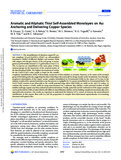Mostrar el registro sencillo del ítem
Aromatic and aliphatic thiol self-assembled monolayers on Au: Anchoring and delivering copper species
| dc.creator | Urcuyo Solórzano, Roberto | |
| dc.creator | Cortés Triviño, Esperanza | |
| dc.creator | Rubert, Aldo A. | |
| dc.creator | Benitez, G. | |
| dc.creator | Montero Villalobos, Mavis Lili | |
| dc.creator | Tognalli, Nicolás G. | |
| dc.creator | Fainstein, Alejandro | |
| dc.creator | Vela, M. E. | |
| dc.creator | Salvarezza, R. C. | |
| dc.date.accessioned | 2022-03-15T16:14:58Z | |
| dc.date.available | 2022-03-16T13:00:12Z | |
| dc.date.issued | 2011 | |
| dc.identifier.citation | https://pubs.acs.org/doi/abs/10.1021/jp207875g | |
| dc.identifier.issn | 1932-7455 | |
| dc.identifier.uri | https://hdl.handle.net/10669/86049 | |
| dc.description.abstract | The immobilization of dinuclear copper(II) acetate complexes (Cu2(CH3COO)4·2H2O) on self-assembled monolayers (SAMs) of different aliphatic and aromatic thiols with oxygen and nitrogen donors at the end group is investigated on preferentially oriented (111) gold surfaces (Au(111)). The Cu species are immobilized at the outer plane of these terminal groups by the interaction of the terminal moiety of the functionalized SAMs. The highest electrochemical activity for the Cu(II)/Cu(I) redox couple is found for the metallic complexes immobilized on SAMs of short thiols, irrespective of their aliphatic or aromatic character, or the nature of the terminal group of the linking molecule, suggesting that direct tunneling is the main path for charge transfer to the Au substrate. Even though a progressive demetalation of the copper acetate complex immobilized on N-terminated SAMs by the release of Cu ions to the solution is induced by repeated potential scans, this process is negligible for Cu species immobilized on O-terminated thiols. The Cu(I)/Cu(0) reaction is not observable in the overall potential range where thiol SAMs are stable on the Au(111) surface. In contrast, this reaction is clearly visible by using nanostructured Au, a substrate that exhibits a wider potential window of SAM stability and larger capture areas than ordered smooth metal surfaces. Finally, spatial 2D and 3D confinement of the copper complex can be performed by SAMs of mixed thiols with different immobilization abilities and by building complex electrochemically active supramolecular structures. Our results are important to understand the behavior of Cu centers of enzymes, the electrochemical metallization of thin organic films with Cu, and the preparation of complex three-dimensional supramolecular Cu-containing structures with spatial order. | en |
| dc.format.extent | 24707-24717 | |
| dc.language.iso | Inglés | |
| dc.source | The Journal of Physical Chemistry C , 115(50), pp. 24707-24717 | |
| dc.subject | Redox reactions | en |
| dc.subject | Thiols | en |
| dc.subject | Gold | en |
| dc.subject | Ions | en |
| dc.subject | X-ray photoelectron spectroscopy | en |
| dc.title | Aromatic and aliphatic thiol self-assembled monolayers on Au: Anchoring and delivering copper species | en |
| dc.type | artículo original | |
| dc.identifier.doi | 10.1021/jp207875g | |
| dc.description.procedence | UCR::Vicerrectoría de Investigación::Unidades de Investigación::Ciencias Básicas::Centro de Investigación en Electroquímica y Energía Química (CELEQ) |
Ficheros en el ítem
Este ítem aparece en la(s) siguiente(s) colección(ones)
-
Biología [1644]


